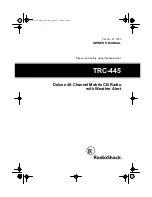
www.maxonamerica.com
7. Safetv Notes & FCC
6. Precautions
19
20
6.1 Precautions for Safe Operation of this equipment.
Don’t remove the antenna from the Radio and don’t transform the antenna or make any changes to the
antenna. Strong electronic waves emitted from the Radio can have an effect on the performance of the
Radio if the antenna is modified and can cause the Radio to have a defect not covered under warranty.
Don’t use other manufacturer’s accessories (such as rechargeable battery, adaptor, external speaker
microphone and earphone, etc.). Unknown or unauthorized accessories may damage the radio and
void the warranty.
Avoid excessive shock to the Radio. Don’t place the Radio where the direct sunlight and/or the high
temperature occurs, battery damage can occur in this environment. Do not disassemble or damage the
battery pack.
Don’t disassemble or reorganize the Radio. The disassembly or reorganization of your radio is
punishable by law and can cause damage to the radio that will not be covered by the warranty
Don’t use frequencies you do not have a permit for.
Please read the following recommendations for safe and effective use of the Radio.
6.2 Do not use the radio where prohibited.
Your radio emits a strong electronic wave which may have an effect on the operation of other
equipment and can also be affected by those other devices.
Please turn off the radio before boarding an airplane. If you want to use the radio during flight, please
adhere to the aircraft’s rules.
If using the radio in an area where medical equipment is being used, please get permission from the
staff before use to prevent interference issues.
Be careful when using your radio in a place where computers or other electronic devices are being
used because the strong electronic waves from the radio can affect this equipment.
Please keep the Radio away at least 1 inch from the body.
Do not touch antenna if it is damaged. Risk of skin burn can occur if the outside surface of antenna
gets stripped out.
Please be careful when putting the battery in a pocket or a bag. If you contact a conductive metal to
a battery terminal, there is a heat and fire risk to your radio.
Please don’t listen to the radio at a high-volume level when using earphones. Loud volume may
have a lasting bad effect on your hearing.
It is recommended to adjust the volume step by step to the level you want after you set the radio
volume of the radio at a low level.
Please don’t remove or replace or charge or discharge the battery in an hazard area where sparks
could cause an electrical fire.
Turn off the radio in areas where there is a strong electromagnetic force.
FCC RF EXPOSURE COMPLIANCE REQUIREMENTS FOR OCCUPATIONAL USE ONLY
The Federal Communications Commission (FCC), with its action in General Docket 93-62, November 7, 1997, has
adopted a safety standard for human exposure to Radio Frequency (RF) electromagnetic energy emitted by FCC
regulated equipment. Proper operation of this radio will result in user exposure far below the Occupational Safety and
Health Act (OSHA) and Federal Communications Commission limits.
•
DO NOT transmit for more than 50% of total radio use time (50% duty cycle). Transmitting more than 50% of the
time can cause FCC RF exposure compliance requirements to be exceeded.
•
This radio is NOT approved for use by the general population in an uncontrolled environment. This radio is
restricted to occupational use, work related operations only where radio operator must have the knowledge to
control the user’s exposure conditions for satisfying the higher exposure limit allowed for occupational use.
•
When transmitting, hold the radio in a vertical position with its microphone 1 inches (2.5 cm) away from your mouth.
•
The radio is transmitting when the red LED on the front of the radio is illuminated. You can cause the radio to
transmit by pressing the PTT bar on the radio.
•
These are required operating configurations for meeting FCC RF exposure compliance. Failure to observe these
restrictions means violation.
This device complies with part 15 of FCC rules. Operation is subject to the following two conditions:(1) This device
may not cause harmful interference and (2) This device must accept any interference received, including interference
that may cause undesired operation.






























